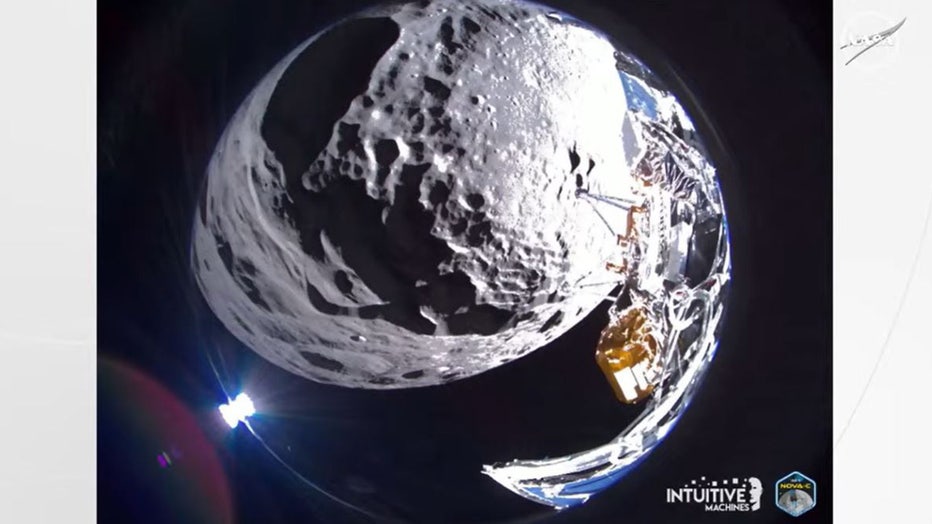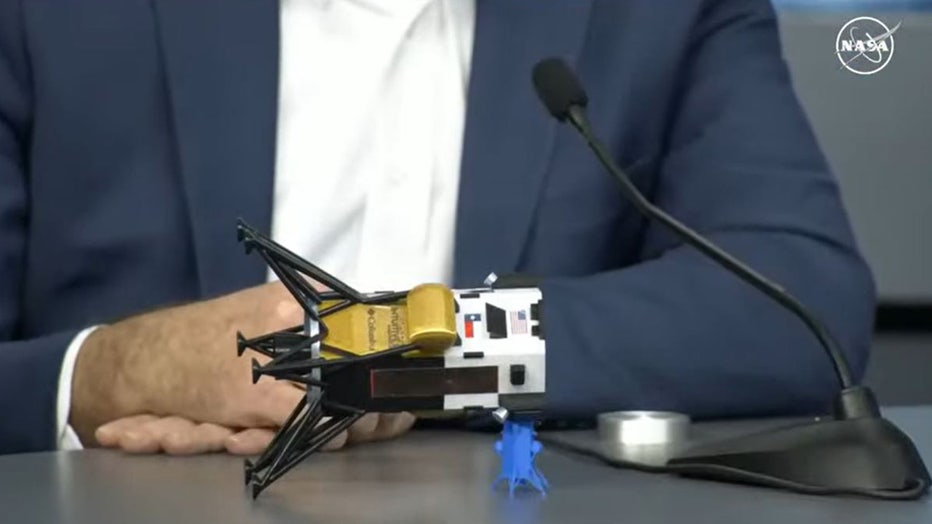US lands on the moon: Odysseus 'Odie' is on its side but ‘alive and well’
The moon’s newest occupant has arrived and it’s said to be "alive and well," but it's also sideways.
During a news conference on Friday, NASA and Intuitive Machines revealed that the lunar lander, Odysseus, is believed to be on its side after making its soft landing on the moon's surface on Thursday.
Coming in at about 6 miles per hour, one of the lander's feet was believed to have gotten caught, causing it to tip over. It is also believed that the lander is being propped up on its side by a rock, and that is based on the sun's movements from the lander's perspective.

FILE - Screenshot taken during a news conference held by NASA and Intuitive Machines showing Odysseus lunar lander on the moon's surface. (NASA/Intuitive Machines)
It was not clear whether or not the lander sustained any damage.
"If you think back from Apollo days, there wasn't one mission that went absolutely perfectly," said Steve Altemus, chief executive officer and co-founder of Intuitive Machines.

FILE - Odysseus lunar lander believed to be on its side, exemplified by Intuitive Machines CEO/co-founder Steve Altemus. (NASA/Intuitive Machines)
As systems are turned on and more data is received, NASA and Intuitive Machines hope to share that information and the status of the lander in the coming days, and this includes photos.
"Very interesting mission so far," Altemus said.
Separately, when Japan's lunar lander made its way to the moon's surface, it landed upside-down.
Japanese Aerospace Exploration Agency's (JAXA) Smart Lander for Investigating the Moon (SLIM) successfully touched down on Jan. 20, but unfortunately, due to its position, the solar panels could not face the sun in order to generate power.
However, the lander achieved it's primary mission was to land within an accuracy range of about 100 meters (330 feet).
Odysseus lunar lander, aka Odie
NASA and Intuitive Machines’ IM-1 mission made history on Feb. 22, as the first successful commercial moon landing and the first American landing in more than 50 years.
The lander’s creator, Intuitive Machines, posted on X, with a brief Day One update of Odysseus’, nicknamed "Odie," condition on Friday.
"Odysseus is alive and well. Flight controllers are communicating and commanding the vehicle to download science data. The lander has good telemetry and solar charging. We continue to learn more about the vehicle’s specific information (Lat/Lon), overall health, and attitude (orientation). Intuitive Machines CEO Steve Altemus will participate in a press conference later today to discuss this historic moment," the tweet read.

Odysseus passes over the near side of the Moon after entering lunar orbit insertion on Feb. 21, 2024. (Intuitive Machines / NASA)
Odysseus launched at 1:05 a.m. on Feb. 15 on a SpaceX Falcon 9 rocket from Launch Complex 39A at NASA’s Kennedy Space Center in Florida.
The mission was sponsored in large part by NASA, whose experiments were on board. NASA paid $118 million for the delivery under a program meant to jump-start the lunar economy.
With Thursday’s touchdown, Intuitive Machines became the first private business to pull off a moon landing, a feat previously achieved by only five countries.
What happened during Odie’s landing?
Breaking down NASA's private lunar landing mission
On Wednesday morning, a robotic lunar lander launched by a Houston company got closer to reaching the moon. On Thursday, it is scheduled to touch down on the moon. If all goes well, it will become the first private spacecraft ever to make a soft landing there and the first American mission to arrive there since Apollo 17 in 1972.
In the final few hours before Odie was set to land on the moon, one of the NASA experiments was pressed into service when the lander's navigation system failed.
The lander took an extra lap around the moon to allow time for the last-minute switch to NASA's laser system, which helped the probe determine its altitude as it approached the lunar surface.
Another experiment, a cube with four cameras, was supposed to pop off 30 seconds before touchdown to capture pictures of Odysseus’ landing. But Embry-Riddle Aeronautical University’s EagleCam was deliberately powered off during the final descent because of the navigation switch and stayed attached to the lander.
Embry-Riddle's Troy Henderson said his team will try to release EagleCam in the coming days, so it can photograph the lander from roughly 26 feet away.
With lingering uncertainty over Odysseus' position on the moon, "getting that final picture of the lander on the surface is still an incredibly important task for us," Henderson told The Associated Press.
Intuitive Machines’ target was 186 miles shy of the south pole, around 80 degrees latitude and closer to the pole than any other spacecraft has come.
The Associated Press, FOX Weather and Stephanie Weaver contributed to this report. This story was reported from Los Angeles.

